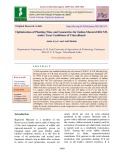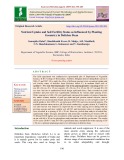
Spacing and nutrient levels
-
Maximum yield is achieved at optimum plant density which depends upon environmental condition, cropping system and cultivar (Bridge et al., 1973; El-Shinnawy and Ghaly, 1985; Halemani and Hallikeri, 2002). However, farmers are adopting various plant geometries with wider row spacings as well as closer plant spacings. As Bt cotton cultivation has resulted in early setting of bolls, ultimately it requires more nutrients. The present study was carried out to know the effect of spacing and fertility levels growth and yield of Bt cotton.
 7p
7p  trinhthamhodang1216
trinhthamhodang1216
 19-11-2020
19-11-2020
 11
11
 2
2
 Download
Download
-
The present investigation was conducted to study how nutrient levels of leaves got changed after pruning and pinching under different spacing.
 7p
7p  nguaconbaynhay8
nguaconbaynhay8
 13-10-2020
13-10-2020
 9
9
 1
1
 Download
Download
-
Weeds are ubiquitous in nature and invade both crop and non-crop lands. When present in crop fields, weeds compete with the crops for nutrients, soil moisture, solar radiation and space; hence reduce their productivity and quality. But, they have been the most underrated crop pests despite the fact that these are weeds which cause heavy loss in crop yield rather than other pests. It has been reported that, out of total loss of agriculture production from several pests in India, weed account for about 37%, insect for 29%, diseases for 22% and other pests for 12%.
 13p
13p  kethamoi6
kethamoi6
 29-06-2020
29-06-2020
 19
19
 1
1
 Download
Download
-
A field experiment was conducted at University Orchard, Horticultural College and Research Institute, Coimbatore to standardize the cropping density and nutrient requirement on growth and development of banana cv. Quintal Nendran (AAB) during 2015-17. The studies were carried out by planting banana suckers at three spacing levels viz., S1–1.8x1.8 m (3086 plants ha-1 ), S2 - 2.1 x 2.1 m (2267 plants ha-1 ), S3 - 2.1 x 2.4 m (1984 plants ha-1 ) with four fertigation levels viz., F1 - 75 per cent, F2 - 100 per cent, F3 - 125 per cent and F4 - 150 per cent RDF.
 9p
9p  gaocaolon5
gaocaolon5
 14-06-2020
14-06-2020
 7
7
 2
2
 Download
Download
-
Spatial distribution of nitrogen, phosphorus and potassium were studied from 99 coconut farmers covering 195 acres representing different irrigation situations in Chikkapattanagere of Chikkamagaluru district, Doddaghatta of Davangere district, Siriyur of Shivamogga district and Madhure of Chitradurga district of Karnataka state, India. The gardens selected were aged 20-25 years with varying management levels.
 13p
13p  kequaidan4
kequaidan4
 05-05-2020
05-05-2020
 12
12
 0
0
 Download
Download
-
Weeds are the part and partial of crop production since evolution of agriculture. Because of their superiority, efficiently harness favourable microclimate at the cost of crop. They mainly compete for mineral nutrients, soil moisture, space and light interception. In berseem field we can successfully achieve weed control below economic threshold level by adapting both precautionary and curative measures in an integrated manner.
 10p
10p  angicungduoc4
angicungduoc4
 04-05-2020
04-05-2020
 23
23
 1
1
 Download
Download
-
A field experiment was conducted to study the response of Lathyrus (Lathyrus sativus L.) on different levels of phosphorus and row spacing on growth and yield under Manipur condition during the rabi season of 2011-12 and 2012-13 at the Research Farm, College of Agriculture, Central Agricultural University, Imphal.
 8p
8p  angicungduoc4
angicungduoc4
 26-04-2020
26-04-2020
 17
17
 0
0
 Download
Download
-
Field experiment was conducted at Zonal Agricultural Research Station, University of Agricultural Sciences, Bengaluru, during kharif 2014 on red sandy loam soil to investigate the effect of spacing and nutrient levels on growth and yield of finger millet.
 7p
7p  angicungduoc4
angicungduoc4
 26-04-2020
26-04-2020
 13
13
 0
0
 Download
Download
-
A field experiment was conducted at College Farm, N. M. College of Agriculture, Navsari Agricultural University, Navsari on a clayey soil during kharif season of 2013-14 and 2014-15 to find out the effect of with four factors viz. three nitrogen levels (100, 150 and 200 kg N ha-1 ), two phosphorus levels (30 and 60 kg P2O5 ha-1 ), two levels of inter-row spacing (20 and 30 cm) and two levels of seed rate (40 and 60 kg ha-1 ) were evaluated in randomized block design with three replications.
 7p
7p  kequaidan4
kequaidan4
 21-04-2020
21-04-2020
 8
8
 0
0
 Download
Download
-
A field experiment was conducted at Main Agricultural Research Station, University of Agricultural Sciences, Dharwad, Karnataka during kharif season of 2016-17 to study the effect of plant spacing and different levels of nutrients on the productivity of buckwheat. The experiment was laid out in split plot design with three replications.
 6p
6p  kethamoi4
kethamoi4
 16-04-2020
16-04-2020
 14
14
 1
1
 Download
Download
-
A Field experiment was conducted at College of Agriculture, V. C. Farm, Mandya, Southern Dry Zone of Karnataka to study the effect of different fertilizer levels and different spacings on nutrient content of okra. The experiment was laid out in split plot design with 3 replications.
 10p
10p  kethamoi4
kethamoi4
 16-04-2020
16-04-2020
 9
9
 0
0
 Download
Download
-
Field experiments was conducted during 2015 on clay loam, sandy loam soil evaluate “to study the Effect of different levels of NPK and Vermicompost on physico-chemical properties of soil” comparison to inorganic fertilizers nitrogen, phosphorous, potassium.
 6p
6p  kethamoi4
kethamoi4
 16-04-2020
16-04-2020
 16
16
 0
0
 Download
Download
-
A field experiment was conducted at Agricultural Research Station (MPUAT), Borwat farm, Banswara (Rajasthan) during the rainy season of 2018 with objective to evaluate the performance of genotypes under varying plant spacing and fertility levels. The treatment consisted with two spacing viz 60x30 cm (55,555 plants/ha) and 60x 25cm (66,666 plants/ha, two fertility level and four sweet corn varieties viz. ASKH-1, Madhuri, Priya and Win-orange. The experiment was Layout in split plot desing with three replicatin.
 6p
6p  caygaocaolon4
caygaocaolon4
 04-04-2020
04-04-2020
 9
9
 0
0
 Download
Download
-
The study was conducted during 2018-19 in Mandya district of Karnataka State, India. The pre-tested interview schedule was used to collect the data from 120 Seasamum growers through personal interview method. The collected data was tabulated and analyzed using percentages, correlation and regression. As high as 44.17 per cent of Seasamum growers belonged to medium level adoption category, 35.00 per cent to low adoption category and 20.83 per cent belonged to high adoption category.
 11p
11p  nguathienthan3
nguathienthan3
 27-02-2020
27-02-2020
 11
11
 0
0
 Download
Download
-
The experiment entitled “Effect of Spacing and Nutrient Management on Growth and Yield of King Chilli (Capsicum chinense Jacq.) grown under Protected Condition” was carried out during the year 2017-2018 under polyhouse at College of Horticulture and Forestry, Central Agricultural University, Pasighat, Arunachal Pradesh. Nine treatments with two factors (spacing and Nutrient) i.e.
 10p
10p  nguathienthan3
nguathienthan3
 27-02-2020
27-02-2020
 21
21
 1
1
 Download
Download
-
The concept of balanced fertilization with proper method at proper time paves the way for optimum profitability of farmers. Since most of the soils in Koshi region of Bihar are sandy clay in their textural class with medium to low in N, P, K and Zn. Due to that farmers of Koshi region applying nutrients unscientifically.
 8p
8p  nguathienthan2
nguathienthan2
 19-12-2019
19-12-2019
 23
23
 1
1
 Download
Download
-
This field experiment was conducted during the kharif season of 2014 and 2015 at the Indira Gandhi Krishi Vishwavidyalaya, Raipur (C.G) to find out the effect of crop arrangement and nutrient management on availability of nutrients under maize and soybean intercropping system. Treatments comprised of six cropping arrangements viz. sole maize (C1), sole soybean (C2), two replacement series of maize + soybean (2:2, C3 and 2:4, C4), two additive series in which two rows (C5) and one row (C6) of soybean were added in-between two rows of maize and four fertility levels viz.
 9p
9p  kethamoi2
kethamoi2
 14-12-2019
14-12-2019
 23
23
 0
0
 Download
Download
-
Experiment was conducted during Kharif season 2018 at New Upland Research Station cum Instructional Farm, Lamker under SG college of Agriculture and Research Station, Jagdalpur, Bastar (CG). The experiment was laid out in split plot design with three replications. Main plot was three levels of fertilizer i.e. F1 (75% RDF), F2 (100% RDF) and F3 (125% RDF), and sub plot was four different spacing viz. S1 (22.5 x 10 cm), S2 (30 x 10 cm), S3 (45 x 10 cm) and S4 (60 x 10 cm). Grain yield, fodder yield per plot and per ha was recorded significantly highest in F3 among fertility levels.
 7p
7p  kequaidan2
kequaidan2
 11-12-2019
11-12-2019
 22
22
 1
1
 Download
Download
-
A field experiment was conducted during the rabi season of 2016-17 at N.E. Borlaug Crop Research Centre of G.B. Pant University of Agriculture and Technology, Pantnagar (290 N, 790 29 E and at an altitude of 243.83 m) to study the effect of planting time and geometry on the growth, yield attributes, yield quality, and the economics of Indian mustard RH 749.
 5p
5p  cothumenhmong1
cothumenhmong1
 08-12-2019
08-12-2019
 14
14
 0
0
 Download
Download
-
The field experiment was conducted at experimental plot of Department of Vegetable Science, K R C College of Horticulture, Arabhavi, Belgaum district during Rabi season of 2016-17 and 2017-18 to study the effect of different spacing levels on nutrient uptake and soil fertility status of dolichos bean (Dolichos lablab L.) in medium black soils of Arabhavi”. Two year field experiments with seven planting geometry consisting of 60 × 15 cm, 60 × 30 cm, 45 × 15 cm (control), 45 × 30 cm, 45 × 45 cm, 30 × 15 cm and 30 × 30 cm were laid out in randomized block design replicated thrice.
 8p
8p  nguaconbaynhay1
nguaconbaynhay1
 08-12-2019
08-12-2019
 11
11
 1
1
 Download
Download
CHỦ ĐỀ BẠN MUỐN TÌM









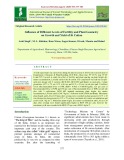
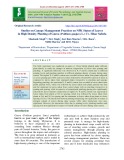
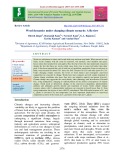
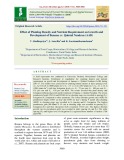
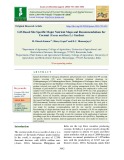
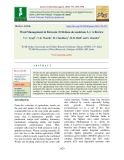
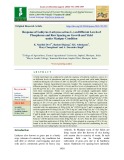
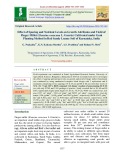
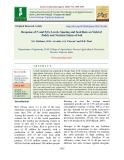
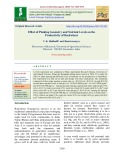
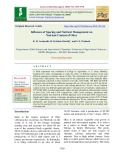
![Effect of different levels of NPK and vermicompost on physico-chemical properties of maize [Zea mays (L.)] Cv. MM2255 Effect of different levels of NPK and vermicompost on physico-chemical properties of maize [Zea mays (L.)] Cv. MM2255](https://tailieu.vn/image/document/thumbnail/2020/20200416/kethamoi4/135x160/9841587051975.jpg)
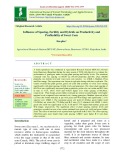
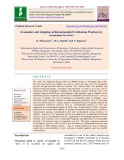


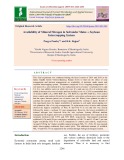
![Effect of different nitrogen levels and plant geometry on yield and nutrient uptake by brown top millet [Brachiaria ramosa (L.)] Effect of different nitrogen levels and plant geometry on yield and nutrient uptake by brown top millet [Brachiaria ramosa (L.)]](https://tailieu.vn/image/document/thumbnail/2019/20191211/kequaidan2/135x160/9261576079325.jpg)
